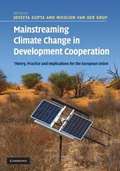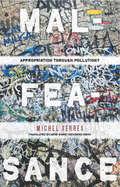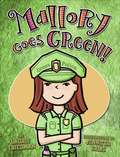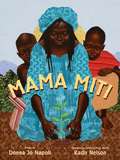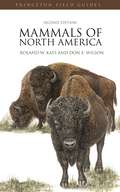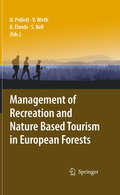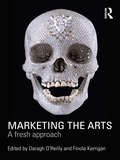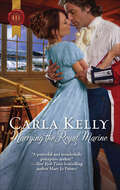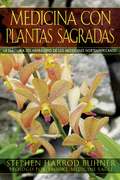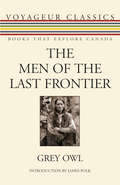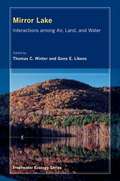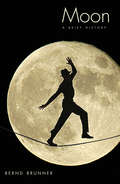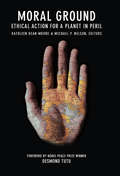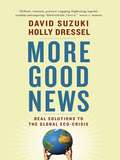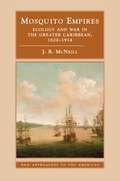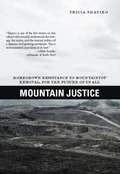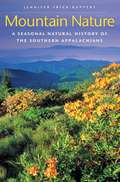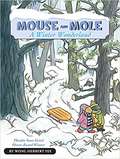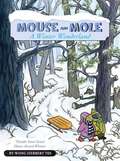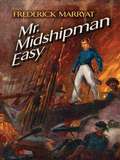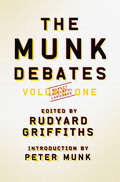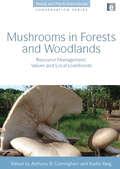- Table View
- List View
Mainstreaming Climate Change in Development Cooperation
by Joyeeta Gupta Nicolien van der GrijpClimate change, development and development cooperation are, individually and jointly, three politically sensitive, complex issues, especially in the context of relations between developed and developing countries. This book tackles these issues by combining theoretical, political, and practical perspectives, analysing the dominant paradigms and exploring the meaning of the concept of mainstreaming. At the practical level, it presents the results of case studies focusing on assistance provided by the European Union and key member states and the climate needs articulated by developing countries. At the political level, it highlights the sensitivities between developed and developing countries and examines the mainstreaming debate in various fora. This book is valuable for policymakers, academics, politicians and non-state actors working in the fields of development studies, international law, politics, international relations, economics, climate change, and environmental studies.
Malfeasance: Appropriation Through Pollution?
by Michel Serres Anne-Marie Feenberg-DibonIn this highly original and provocative book, Michel Serres reflects on the relation between nature and culture and analyzes the origins of the world's contemporary environmental problems. <P><P>He does so through the surprising proposition that our cleanliness is our dirt. <P>While all living beings pollute to lay claim to their habitat, humans have multiplied pollution's effects catastrophically since the Industrial Revolution through the economic system's mode of appropriation and its emphasis on mindless growth. He warns that while we can measure what he calls "hard pollution"--the poisoning of the Earth--we ignore at our peril the disastrous impact of the "soft pollution" created by sound and images on our psyches. <P>Sounding the alarm that the planet is heading for disaster, Serres proposes that humanity should stop trying to "own" the world and become "renters." Building on his earlier work, especially that on hominization, he urges us to establish a "natural contract" with nature.
Mallory Goes Green (Mallory, Book #13)
by Laurie FriedmanMALLORY McDONALD IS GOING GREEN! As an official member of the Fern Falls Elementary Environmental Committee, Mallory is super excited to make her school and home more environmentally friendly. She's even selected to be class representative for the all-school Green Fair. But the minute Mallory goes green, everything goes wrong. No one wants her "expert" opinion on how to help the environment. Her classmates don't want to participate in the Green Fair project she's created. And worst of all, by the time the fair rolls around, many of them aren't even speaking to Mallory. Can Mallory find a way to save the planet and her friendships?
Mama Miti: Wangara Maatha and the Trees of Kenya
by Donna Jo NapoliOne woman. One seed. One hope for the future. Thayu nyumba--Peace, my people. Wangari grew up in the shadow of Mount Kenya listening to the stories about the people and the land around her. Though the trees towered over her, she had loved them for as long as she could remember. So strong, so beautiful, how the trees made her smile. Wangari planted trees one by one to refresh her spirit. When the women came to her for help with their families, she told them to do the same. Soon the countryside was filled with trees. Kenya was strong once more. Wangari had changed her country, tree by tree. Donna Jo Napoli tells a story inspired by the life of 2004 Nobel Peace Prize recipient Wangari Maathai that will touch the hearts and spirits of all who read it. Kadir Nelson's stunning collage illustrations honor the spirit of a land and of the woman who saved it. In honor of the publication of this book, the publisher has made a donation to the Green Belt Movement to plant trees in Kenya. For more information on the Green Belt Movement, visit greenbeltmovement.org.
Mammals of North America: Second Edition (Princeton Field Guides #58)
by Roland W. Kays Don E. WilsonThe best field guide to North American mammalsThe best-selling field guide that "sets new standards" (New Scientist) and "makes all other field guides for mammals of the United States. . . and Canada obsolete" (Journal of Mammalogy) is now even better. Covering 20 species recognized since 2002 and including 13 new color plates, this fully revised edition of Mammals of North America illustrates all 462 known mammal species in the United States and Canada—each in beautiful color and accurate detail. With a more up-to-date species list than any other guide, improved facing-page descriptions, easier-to-read distribution maps, updated common and scientific names, and track and scat illustrations, this slim, light, and easy-to-use volume is the must-have source for identifying North American mammals.Roland Kays and Don Wilson have scoured the technical literature to pull out the key differences between similar species, and illustrated these whenever possible, making the guide useful to amateur naturalists and professional zoologists alike. Casual animal watchers will appreciate the overview of mammal diversity and the tips on identifying animals they can spy in their binoculars, while scientists will appreciate the exacting detail needed to distinguish similar species, including illustrations of shrew teeth, bat toes, and whale dorsal fins.The best-illustrated and easiest-to-use field guide to North American mammalsBeautiful and accurate color illustrations of all 462 mammals found in the United States and Canada—including 20 species recognized since 2002112 color plates—including 13 new onesKey identification information—fully revised—on facing pagesThe most current taxonomy/species listFully revised, easy-to-read range mapsIllustrations of tracks, scat, and whale and dolphin dive sequences
Management of Recreation and Nature Based Tourism in European Forests
by Veronika Wirth Simon Bell Ulrike Pröbstl Birgit H. ElandsThis book provides for the first time a Europe-wide overview on the state of the art of management of recreation and nature tourism in forests. It describes the current situation and conflicts in the different regions of Europe and provides solutions illustrated by good practise examples. It addresses traditions, differences and similarities in European forests as well as new tasks, goals and strategies. The final discussion provides a profound insight into future trends regarding forest recreation and nature based tourism.
Marketing the Arts: A Fresh Approach
by Daragh O'Reilly Finola KerriganIn recent years, there have been significant shifts in arts marketing, both as a practice and an academic discipline. The relationship between art and the market is increasingly complex and dynamic, requiring a transformation in the way the arts are marketed. Marketing the Arts argues that arts marketing is not about the simple application of mainstream managerial marketing to the arts. With contributions from international scholars of marketing and consumer studies, this book engages directly with a range of contemporary themes, including: The importance of arts consumption and its social dimensions The importance of the aesthetic experience itself, and how to research it Arts policy development The art versus commerce debate The role of the arts marketer as market-maker The artist as brand or entrepreneur This exciting new book covers topics as diverse as Damien Hirst’s 'For the Love of God', Liverpool’s brand makeover, Manga scanlation, Gob Squad, Surrealism, Bluegrass music, Miles Davis and Andy Warhol, and is sure to enthuse students and enlighten practitioners.
Marrying the Royal Marine
by Carla KellyA young woman’s journey to help in the war against Napoleon brings her close to a brave and caring officer in this historical romance.As the illegitimate daughter of a nobleman, Polly Brandon has always felt like an ugly duckling. So she’s amazed when Lieutenant Colonel Hugh Philippe Junot pays her such close attention as they sail for Portugal. She knows this Royal Marine would never look at her under ordinary circumstances, but having his protection is more than a comfort . . . it is a pleasure.Hugh is immediately taken with the spirited beauty aboard his ship. Her determination to assist with the war effort is admirable, and when she falls ill, he feels compelled to care for her. But Polly still has trouble believing what she sees in Hugh’s eyes—that she has turned from an ugly duckling into a desirable swan . . .
Medicina con plantas sagradas: La sabiduría del herbalismo de los aborígenes norteamericanos
by Brooke Medicine Eagle Stephen Harrod BuhnerEl primer examen en profundidad de los fundamentos sagrados del mundo del herbalismo medicinal de los aborígenes norteamericanos • Revela cómo los chamanes y sanadores “hablan” con las plantas para descubrir sus propiedades medicinales • Incluye las oraciones y canciones medicinales vinculadas con el uso de cada una de las plantas examinadas A medida que los seres humanos evolucionaron en la Tierra, utilizaron plantas para todo lo imaginable --alimentos, armas, canastas, vestimentas, refugio y remedios de salud. En su libro Medicina con plantas sagradas, Stephen Harrod Buhner analiza la relación de larga data entre los pueblos aborígenes y las plantas y examina las técnicas y estados mentales que utilizan estas culturas para comunicarse con el mundo botánico. El autor explora la dimensión sagrada de las interacciones entre seres humanos y plantas --un territorio en el que los humanos experimentamos la comunicación con las plantas como expresiones del Espíritu. Con respecto a cada planta curativa descrita en el libro, el autor presenta sus usos medicinales, normas para su preparación y elementos ceremoniales como las oraciones y canciones medicinales vinculadas con el uso de la planta.
The Men of the Last Frontier
by Grey Owl James PolkIn 1931 Grey Owl published his first book, The Men of the Last Frontier, a work that is part memoir, part history of the vanishing wilderness in Canada, and part compendium of animal and First Nations tales and lore. A passionate, compelling appeal for the protection and preservation of the natural environment pervades Grey Owls words and makes his literary debut still ring with great relevance in the 21st century. By the 1920s, Canadas outposts of adventure had been thrust farther and farther north to the remote margins of the country. Lumbermen, miners, and trappers invaded the primeval forests, seizing on natures wealth with soulless efficiency. Grey Owl himself fled before the assault as he witnessed his valleys polluted with sawmills, his hills dug up for hidden treasure, and wildlife, particularly his beloved beavers, exterminated for quick fortunes.
Mirror Lake: Interactions Among Air, Land, and Water
by Thomas C. Winter Gene E. LikensLakes change constantly in response to their surrounding landscape, and their airshed. Mirror Lake, located in the White Mountains of New Hampshire, has been carefully researched since the 1960s. This book, edited by Thomas C. Winter and Gene E. Likens, summarizes and interprets the extensive data collected on this lake and its watershed from 1981 to 2000, a period during which the lake was affected by a variety of climate conditions as well as significant human activity. The findings documented also identify the panoply of chemicals influenced by limnological processes and include percentages of inflow sources, percentages of water loss from seepage, surface outflow, and evaporation, and the effect of water flow on the lake nutrients.
Molecular Approaches in Natural Resource Conservation and Management
by Keith E. Woeste Jr. J. Andrew Dewoody John W. Bickham Charles H. Michler Krista M. Nichols Olin E. RhodesRecent advances in molecular genetics and genomics have been embraced by many in natural resource conservation. Today, several major conservation and management journals are now using "genetics" editors to deal solely with the influx of manuscripts that employ molecular data. The editors have attempted to synthesize some of the major uses of molecular markers in natural resource management in a book targeted not only at scientists but also at individuals actively making conservation and management decisions. To that end, the text features contributors who are major figures in molecular ecology and evolution - many having published books of their own. The aim is to direct and distill the thoughts of these outstanding scientists by compiling compelling case histories in molecular ecology as they apply to natural resource management.
Moon: A Brief History
by Bernd BrunnerWerewolves and Wernher von Braun, Stonehenge and the sex lives of sea corals, aboriginal myths, and an Anglican bishop: In his new book, Moon, Bernd Brunner weaves variegated information into an enchanting glimpse of Earth's closest celestial neighbor, whose mere presence inspires us to wonder what might be "out there." Going beyond the discoveries of contemporary science, Brunner presents an unusual cultural assessment of our complex relationship with Earth's lifeless, rocky satellite. As well as offering an engaging perspective on such age-old questions as "What would Earth be like without the moon?" Brunner surveys the moon's mythical and religious significance and provokes existential soul-searching through a lunar lens, inquiring, "Forty years ago, the first man put his footprint on the moon. Will we continue to use it as the screen onto which we cast our hopes and fears?" Drawing on materials from different cultures and epochs, Brunner walks readers down a moonlit path illuminated by more than seventy-five vintage photographs and illustrations. From scientific discussions of the moon's origins and its "chronobiological" effects on the mating and feeding habits of animals to an illuminating interpretation of Bishop Francis Godwin's 1638 novelThe Man in the Moone, Brunner's ingenious and interdisciplinary explorations recast a familiar object in an entirely original and unforgettable light and will change the way we view the nighttime sky.
Moon Florida Gulf Coast: Best Beaches, Wildlife, Everglades Adventures (Moon U.S. Travel Guide)
by Joshua Lawrence Kinser Moon Travel GuidesWhether you're kayaking through mangroves, bodysurfing with manta rays, or sunbathing with a piña colada in hand, soak up the Sunshine State with Moon Florida Gulf Coast. Inside you'll find: Flexible itineraries including a 5-day family vacation, a baseball spring training trip, and a 10-day road trip covering all 700 miles of the Florida Gulf Coast The best spots for outdoor adventures like kayaking, hiking, biking, bird-watching, and fishing, and the best beaches for swimming, sunsets, and seclusion Top activities and unique experiences: Discover the vibrant performing arts scene in Sarasota or stroll through quaint riverfront towns and secluded island enclaves. Unwind on shell-scattered beaches or spot gators in the swampy Everglades. Ride the coasters at Busch Gardens, browse art galleries in Naples, or catch a college baseball game during Spring Training. Sail through the canals of Tampa, kick back at a beachfront oyster bar, and sip a local brew as the sun sets over the ocean Expert advice from Florida local Joshua Lawrence Kinser on where to stay, what to eat, and how to get around by car, bus, or boat Full-color photos and detailed maps throughoutBackground information on the Gulf Coast's landscape, wildlife, history, and culture Experience the best of Florida's Gulf Coast with Moon. For more of the Sunshine State, try Moon Florida Keys.About Moon Travel Guides: Moon was founded in 1973 to empower independent, active, and conscious travel. We prioritize local businesses, outdoor recreation, and traveling strategically and sustainably. Moon Travel Guides are written by local, expert authors with great stories to tell—and they can't wait to share their favorite places with you. For more inspiration, follow @moonguides on social media.
Moral Ground
by Kathleen Dean Moore Michael P. Nelson<P>Moral Ground brings together the testimony of over eighty visionaries-theologians and religious leaders, scientists, elected officials, business leaders, naturalists, activists, and writers-to present a diverse and compelling call to honor our individual and collective moral responsibility to our planet. In the face of environmental degradation and global climate change, scientific knowledge alone does not tell us what we ought to do. The missing premise of the argument and much-needed center piece in the debate to date has been the need for ethical values, moral guidance, and principled reasons for doing the right thing for our planet, its animals, its plants, and its people. <P>Contributors from throughout the world (including North America, Africa, Australia, Asia, and Europe) bring forth a rich variety of heritages and perspectives. Their contributions take many forms, illustrating the rich variety of ways we express our moral beliefs in letters, poems, economic analyses, proclamations, essays, and stories. In the end, their voices affirm why we must move beyond a scientific study and response to embrace an ongoing model of repair and sustainability. These writings demonstrate that scientific analysis and moral conviction can work successfully side-by-side. <P>This is a book that can speak to anyone, regardless of his or her worldview, and that also includes a section devoted to "what next" thinking that helps the reader put the words and ideas into action in their personal lives. Thanks to generous support from numerous landmark organizations, such as the Kendeda Fund and Germeshausen Foundation, the book is just the starting point for a national, and international, discussion that will be carried out in a variety of ways, from online debate to "town hall" meetings, from essay competitions for youth to sermons from pulpits in all denominations. The "Moral Ground movement" will result in a newly discovered, or rediscovered, commitment on a personal and community level to consensus about our ethical obligation to the future.
More Good News
by David Suzuki Holly DresselIn this edition of their bestseller, the sequel to the best-selling Good News for a Change, authors David Suzuki and Holly Dressel provide the latest inspiring stories about individuals, groups, and businesses that are making real change in the world. More Good News features the most up-to-date information about critical subjects, such as energy and the economy, not covered in the previous edition. These stories offer compelling proof from the front lines that sustainable solutions already exist.
Mosquito Empires: Ecology and War in the Greater Caribbean, 1620-1914
by J. R. McNeillThis book explores the links among ecology, disease, and international politics in the context of the Greater Caribbean - the landscapes lying between Surinam and the Chesapeake - in the seventeenth through early twentieth centuries. Ecological changes made these landscapes especially suitable for the vector mosquitoes of yellow fever and malaria, and these diseases wrought systematic havoc among armies and would-be settlers. Because yellow fever confers immunity on survivors of the disease, and because malaria confers resistance, these diseases played partisan roles in the struggles for empire and revolution, attacking some populations more severely than others. In particular, yellow fever and malaria attacked newcomers to the region, which helped keep the Spanish Empire Spanish in the face of predatory rivals in the seventeenth and early eighteenth centuries. In the late eighteenth and through the nineteenth century, these diseases helped revolutions to succeed by decimating forces sent out from Europe to prevent them.
Mountain Justice
by Tricia Shapiro"Shapiro is one of the few writers on this subject that actually understands the strategy, the tactics, and the internal politics of a dynamic and growing movement. This is environmental journalism at it best."-Mike Roselle, Earth First! founder and author of Tree SpikerMountaintop removal (MTR) does exactly what it says: a mountaintop is stripped of trees, blown to bits with explosives, then pushed aside by giant equipment-all to expose a layer of coal to be mined. Hundreds of thousands of acres of ancient forested mountains have been "removed" this way and will never again support the biologically rich and diverse forest and stream communities that evolved there over millions of years-all to support our flawed national energy policy.Mountain Justice tells a terrific set of firsthand stories about living with MTR and offers on-the-scene-and behind-the-scenes-reporting of what people are doing to try to stop it. Tricia Shapiro lets the victims of mountaintop removal and their allies tell their own stories, allowing moments of quiet dignity and righteous indignation to share center stage. Includes coverage of the sharp escalation of anti-MTR civil disobedience, with more than 130 arrests in West Virginia alone during the first year of the Obama administration.Tricia Shapiro has been closely following and writing about efforts to end large-scale strip mining for coal in Appalachia since 2004. She now lives on a remote mountain homestead in western North Carolina, near the Tennessee border.
Mountain Nature
by Jennifer Frick-RuppertThe Southern Appalachians are home to a breathtakingly diverse array of living things--from delicate orchids to carnivorous pitcher plants, from migrating butterflies to flying squirrels, and from brawny black bears to more species of salamander than anywhere else in the world. Mountain Nature is a lively and engaging account of the ecology of this remarkable region. It explores the animals and plants of the Southern Appalachians and the webs of interdependence that connect them.Within the region's roughly 35 million acres, extending from north Georgia through the Carolinas to northern Virginia, exists a mosaic of habitats, each fostering its own unique natural community. Stories of the animals and plants of the Southern Appalachians are intertwined with descriptions of the seasons, giving readers a glimpse into the interlinked rhythms of nature, from daily and yearly cycles to long-term geological changes. Residents and visitors to Great Smoky Mountains or Shenandoah National Parks, the Blue Ridge Parkway, or any of the national forests or other natural attractions within the region will welcome this appealing introduction to its ecological wonders.
Mouse and Mole: A Winter Wonderland (Fountas & Pinnell LLI Blue #Level L)
by Wong YeeBest friends Mouse and Mole enjoy playing in the snow with Sno-Mouse and Sno-Mole, two more best friends.
Mouse and Mole: A Winter Wonderland
by Wong Herbert YeeA story of two good friends in snowy winter - Mouse and Mole , who enjoy each other's company even they are not playing together.
Mr. Midshipman Easy
by Frederick Marryat John HarlandIn this stirring tale from the days of wooden ships, a young sailor enters the king's service with some firm but untried egalitarian notions. "Equality Jack" -- known formally as Mr. Midshipman Easy -- is initiated into the rigid hierarchy of the Royal Navy during the Napoleonic Wars. His adventures were recounted in 1836 by the founder and master of naval fiction, Captain Frederick Marryat (1792-1848), who entered the service as a fourteen-year-old midshipman and resigned twenty-four years later to devote himself to writing. He based this novel on his own experiences sailing with Lord Thomas Cochrane, the real-life model for Horatio Hornblower and Jack Aubrey. Marrayat combines a sharp wit and sense of irony with realism born of firsthand knowledge of seafaring life. Joseph Conrad praised his works as "enthralling," adding, "His greatness is undeniable." Virginia Woolf declared, "Marryat has the power to set us in the midst of ships and men and sea and sky, all vivid, credible, authentic." This low-priced Dover edition of Marryat's classic includes 37 illustrations and features an Introduction by author John Harland, an expert on maritime literature.
Multilateral Environmental Agreements
by Bharat H. DesaiThe present study seeks to examine the genesis, development, and proliferation of multilateral environmental agreements (MEAs) - in-built law-making mechanisms and processes of institutionalization - and their ad hoc treaty-based status and the issue of the legal personality of their secretariats. It provides legal understanding of the location of MEA secretariats within an existing international host institution, as well as discussion of the issue of relationship agreements and interpretation of the commonly used language that triggers such relationships. It places under scrutiny the standard MEA phrase "providing a secretariat," delegation of authority by the host institution to the head of the convention secretariat, possible conflict areas, host country agreement, and the workings of the relationship agreements. The book offers an authoritative account of the growing phenomenon in which an existing international institution provides a servicing base for MEA that, in turn, triggers a chain of legal implications involving the secretariat, the host institution, and the host country.
The Munk Debates (The Munk Debates)
by Rudyard GriffithsThe Munk Debates is Canada's premier international debate series, a highly anticipated cultural event and feast of ideas. Launched in 2008 by philanthropists Peter and Melanie Munk, these debates bring together some of the world's greatest thinkers to discuss the most pressing political, social, and cultural issues that are shaping the course of world events. This volume includes an Introduction by Peter Munk and the first five debates in the series: British historian and bestselling author Niall Ferguson, top-ranking American diplomat Richard Holbrooke, Washington Post columnist Charles Krauthammer, and human rights scholar and Pulitzer Prize-winning author Samantha Power discuss global security and the 2008 U.S. presidential election, Former U.S. Ambassador to the United Nations John Bolton, former Foreign Minister of the Australian Parliament and President and Chief Executive of the International Crisis Group Gareth Evans, actor and humanitarian Mia Farrow, and former Chief of the Defence Staff of the Canadian Forces General Rick Hillier debate the pros and cons of humanitarian intervention. Professor of Economics Paul Collier, economist Hernando De Soto, former UN Secretary-General Stephen Lewis, and bestselling author of Dead Aid Dambisa Moyo explore the opportunities and hazards of foreign aid. Former British politician and bestselling author Lord Nigel Lawson, adjunct professor at the Copenhagen Business School and bestselling author Bjørn Lomborg, environmental activist and Leader of the Green Party of Canada Elizabeth May, and journalist and bestselling author George Monbiot tackle one of the great public policy questions of our time: how should the world respond to climate change? Intelligent, informative, and entertaining, The Munk Debates is a lively forum of ideas and opinions that aims to reinvigorate public discourse and civic dialogue, and captures the prevailing moods, clashing opinions, and most imperative issues of our time.
Mushrooms in Forests and Woodlands: Resource Management, Values and Local Livelihoods (People and Plants International Conservation)
by Anthony B. Cunningham Xuefei YangMany mushrooms - or the 'fruits of fungi' - are extremely valuable, wild-gathered products which are utilised for both their medicinal properties and as food. In many of the world's tropical and temperate forests, they are the primary source of income for the people who live there. These forests range from temperate woodlands and small forests to high altitude forests in the Himalaya and tropical miombo woodlands in south-central Africa. In south-west China, over 200 species of wild fungi in 64 genera are commercially traded while in Europe and North America, woodlands and small forests are the source of many highly-prized mushrooms and an essential resource for many small enterprises and collectors. Yet the increased demand for timber has resulted in the rapid expansion of forestry, which in turn has destroyed the natural habitat of many fungi, unbalancing both forest economics and ecology. Despite the economic, social and cultural values of fungi, there is a general lack of understanding of their importance to local livelihoods and forest ecology. This book aims to fill this gap and extends the People and Plants Conservation Series beyond the plant kingdom into the related world of fungi and mushrooms. It demonstrates the crucial roles that fungi play in maintaining forest ecosystems and the livelihoods of rural people throughout the world while providing good practice guidelines for the sustainable management of this resource and an assessment of economic value. It brings together the perspectives of biologists, anthropologists and forest and woodland managers to provide a unique inter-disciplinary and international overview of the key issues.
